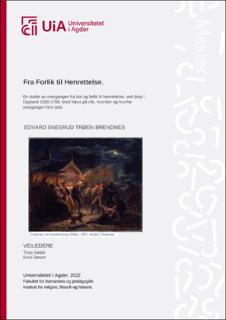| dc.description.abstract | The theme for this dissertation is which consequence a homicide should get in the early modern era. There were two ways one could be punished; either execution or settlement with the descendant of the victim, and a fine to the Crown. During the seventeenth century there was a transition where the possibility for settlement and fines disappeared. Research of this topic have not been done previously, with the exception of Terje Sødal´s research for Agder between 1603-1660. The goal of this dissertation is to survey the transition from settlement and fines for most homicides, to execution for all homicide during the seventeenth century. How, when and why did these changes happen? Geographically I will restrict this dissertation to examine the old Oppland County in Norway, in the period between 1550-1700 to look at the larger trends with Oppland as the starting point. The dissertation will build upon a wide amount of source material, such as letters (diplomer) and protocols from the courts (Tingbøker/lagtingsprotokoller/herredagsprotokoller). However the main source will be the county accounts (Lensregnskaper). It will build upon different ways to understand the Danish-Norwegian state’s approach with the people, as a bargaining state (forhandlingstat) or a power state (maktstaten). The two main theoretical approaches to explain the transition are civilization theory, and the disciplining theory.
I was able to locate 104 homicides in Oppland between 1550-1700, where there were clear geographical and temporally differences. Isolated areas carry the mark of higher homicide rates, where I argue for an extension of the “violent belt” (voldsbelte) from the inner parts of Agder in the south, and up to the north of Gudbrandsdalen, and not in Hadeland as the northern part as Jørn Sandnes argued. Against previous research I claim that the self-ownership share of land did not influence the geographical spread of homicides in Oppland. The transition from settlements and fines to execution happened between 1610-1630. The shift is connected to the local judge’s (sorenskriver) increased formal and informal justification with increased possibility for the power state to control the people. Among other things through religion’s changed view on how to deal with conflicts, from a reconciliation mentality, to a royal duty to insure the people’s obedience above God. But the people were advocates for a continuity in their wish to keep settlement and fines as a possibility for homicides. Something the state partially adapted its form for government through negotiation and co-operation, in line with the principle of a bargaining state. This is due to knowledge between the parties, and it was useful for the people to keep the remains of the bargaining state where they had influence in the process around dealing with homicides. One can trace the remains of the influence from feud-culture norms and rules in how the people react and handled homicides and settlement. | |
